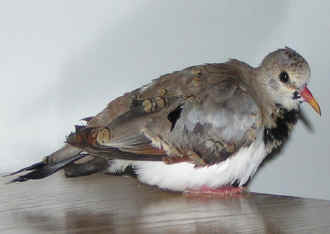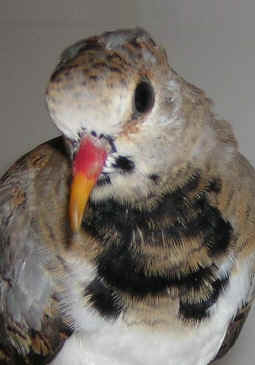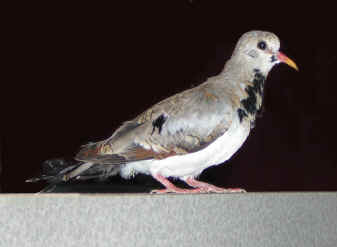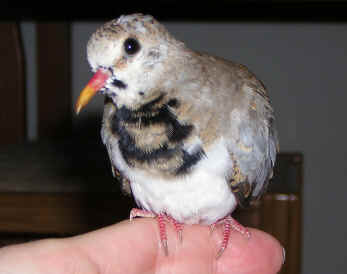MAIN MENU
Diamond Doves
Site Map
Diamond doves
Acquiring Diamond Doves
Caring for Diamonds
Living With Diamonds
Raising Diamonds
Growth of a Diamond Baby
One Year's Reproduction Data
Tribute to China
Other Dove Species
Other Geopelia SpeciesRingneck Doves
Eurasian Collared Doves
Cape Doves
Mourning Doves
Mourning Dove Baby Growth
Rock doves
North American Doves
Dove Genera of the World
All Doves
Caring for Injured or Sick DovesTaming Doves
Other
Books of Interest
Some Bird stories
About Me
Links
Informational Sites
American Dove AssociationCommercial Sites
Jeff Dowining - Diamond DovesGarrie Landry - Diamond Doves
Wade Oliver - The Dove Page
Doveland Press - Diamond Doves
Cape Dove
Oena capensis (Linnaeus 1776)

The above photograph was taken by Crimson of Hong Kong
All the remaining photographs on this page were
taken by Nathalie Champagne of Montreal, Canada. The first four photos
were taken of a 4 month old male cape that hatched out in January 25, 2007.
The photo of the adult male cape dove was taken one year later when he was about
1 year and 4 months old. The following photo is of a two month old
female cape dove that hatched out March 16, 2008.
D R A F T
Introduction
The Cape Dove is also known as the Masked Dove, Namaqua Dove, and Long-tailed Dove. It is the single species of the genus Oena. There are two recognized sub-species. (2)(6)- Oena capensis capensis (Linnaeous, 1766) is found in all of the Africa and Middle Eastern range
- Oena capensis aliena (Bans, 1918) is found in Madagascar. This subspecies is similar to the nominate but is smaller, darker, and grayer overall.
 Description
Description
Cape doves are slightly larger than diamond doves. The average body weight is about 40 grams and length is 20 to 22 cm. Their bodies are about the same size as the diamonds, but their tail is much longer. The face, throat, and upper chest of the adult male bird is black with a white border around the top of the head, and sides of the head, throat and chest. This is the black mask that characterizes the male bird. Male birds do not have the black mask until after they are sexually mature or more than six to eight months old.
The female has a
whitish gray face. Her outer wing coverts are a lighter gray than the male's.
 Distribution
Distribution
The cape dove is found throughout much of the sub-Saharan part of the African continent, Madagascar, and in several locations in the Middle East. It does not occur in the humid tropics of central Africa. This dove is noted for the apparent expansion of its range in many locations. (2)
Habitat
The cape doves are usually found in dry, open habitat with some scrub vegetation which is used for cover. Sometimes they are found in dry wooded areas. Like many other doves they can be seen in villages and towns in gardens and parks, and also in cultivated areas.
Feeding
Feeds on fallen small seeds of grasses and
weeds where the ground is bare in open spaces among thorn scrub, roadsides, paths, and in gardens. The bird walks and runs about very quickly while feeding. These birds are also very swift fliers.
The cape dove also is known to feed on small insects. (1)
Reproduction

Cape doves build the usual type of dove nest except that the nest is usually tightly constructed. It is usually constructed low to the ground. The female usually lays two cream colored eggs. The eggs are usually incubated for 14 days and babies are reported to fledge in 16 to 18 days(1). Cape dove juveniles begin to color up in four months and reach sexual maturity within six to eight months (5). Brown(1) writes that in captivity there is generally a predominance of male doves produced often making it difficult to find hens for sale.
Birds Kept in Captivity
Many who have written about keeping cape doves stress that these birds are not cold hardy nor can they stand excessive levels of humidity. If the bird are kept in a temperate environment they either need to be taken inside in the winter or kept in an aviary that includes a heated shelter. One breeder refused to sell me any of his capes because the temperature in my apartment goes down to 58 degrees F in the winter (14 degrees C) On the other hand Gos (4) writes they are very cold hardy and can be kept in a unheated aviary year around although he did not mention any temperature limitations. Some say the Gulf Coast is to humid for these doves but one breeder had a male cape that lived for 14 years. There seems to be some feeling that capes bred in this country in recent years are not as hardy as those kept ten to twenty years ago.
Most people that keep cape doves have them in outside aviaries that offer plenty of direct sunlight and of course protection from rain and some shade. A large area with some bare ground is desirable for feeding, sitting in the sun, and taking dust baths. It is reported that unlike the diamonds, capes can rarely be kept in cages without their feathers being trashed. Some people report that they are keeping the capes loose in their homes to avoid the destruction of the capes' beautiful long tail as well as their wing feathers.
The Honolulu Zoo recommends a good quality of parakeet mix with small millets and turkey crumbles for cape doves in captivity. Brown (1) suggest a finch, budgerigar, or small parrot mix supplemented with greens such as silverbeet and/or chickweed.
In an aviary. capes are usually good breeders although some say that the use diamonds as foster parents when cape refuse to feed their young. Many suggest that it is best to have one breeding pair in an aviary. When male juveniles reach the age of four months they may begin to fight with the adult males and thus need to be separated from their parents.
About Nathalie's Birds
Nathalie Champagne acquired these two cape dove from a Montreal breeder. The male hatched out on January 25, 2007 and these photos were taken four months later in May 2007. The male's black mask was just starting to grow in. The photo showing the grown in black mask was taken in May 2008.
The female hatched a year after the male, on March 16, 2008 and the photos below were taken in May 2008.
Nathalie was unable to obtain a female at the same time she obtained the male time because cape dove pairs seem to be producing far more males than they are producing females. In fact this seems to be a general trend, so much so that people are beginning to charge more money for the female capes than the male capes. Thus at this time we do not have a photo of an adult female
Adult Male Cape Dove
I include the cape dove here because I believe it is an interesting bird. While I am not raising any at this time I hope to obtain a pair in the near future. These birds are very quick in their movements but are reportedly easy to tame and then will be a quiet, calm bird. Some references indicate that they can only be raised in an outside flight cage, but I have heard others have been able to produce offspring by using an inside cage.

Juvenile Female Cape Dove
These doves apparent prefer more privacy for mating and nesting than the diamonds, so some kind of vegetative cover may be helpful. Like the other doves included on this site, these birds appreciate time in the sun. Thus if their environment can include a window that provides sunlight the birds will be happier. Most people feed cape doves the same kind of diet used for the diamond doves. Although they are reported to breed easily if seclusion is provided, sometimes problems occur if the babies fledge too quickly, end up on the cage floor and are not fed by their parents.

Male and Female Cape Dove
References
(1) Brown, Danny, "Masked Dove, Oena capensis", A Guide to Pigeons, Doves & Quail, Their Management, Care & Breeding, South Tweeds Heads, Australia: Australian Birdkeeper 1995, pp. 132-134(2) Gibbs, David; Barnes, Eustace; Cox, John "Namaqua Dove, Oena capensis", Pigeons and Doves, A Guide to Pigens and Doves of the World, London: Yale University Press 2001, pp. 289- 291
(3) Goodwin, Derek, "Masked Dove, Oena capensis", Pigeons and Doves of the World, London: Trustees of the British Museum (Natural History), 1967, pp. 171-172
(4) Gos, Michael W., "Cape Dove," Doves. Neptune City, NJ: T.F.H. Publications, Inc., 1989, p. 84-85
(5) Anonymous,
"Masked or Cape Dove (On-line), Accessed October 14, 2008 at
//www.honoluluzoo.org/masked_or_cape_dove.htm
(6) Vriends, Matthew M., PhD., "Cape Dove (Oena capensis)", Doves, A Complete Pet Owner's Manual. Happauge, NY: Barrons Educational Series, Inc., 1994 , pp. 81-83
Helen White
P. O. Box 367,
Tallahassee, FL 32302-0367
Last revised on: October 15, 2008